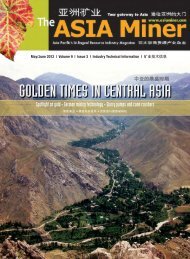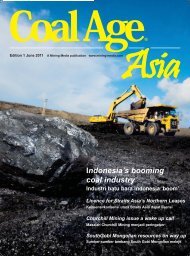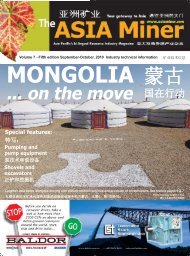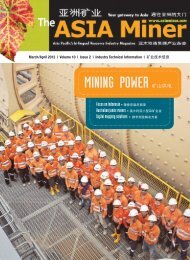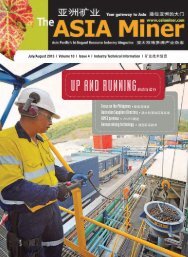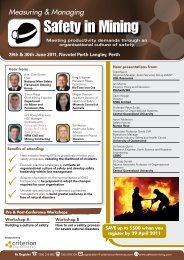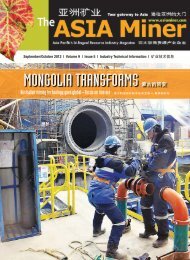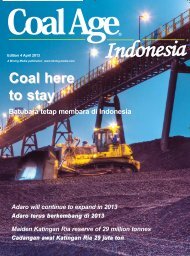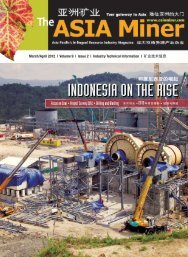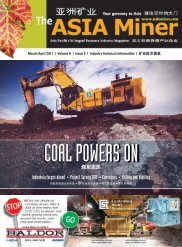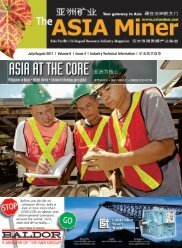May/June 2013 - The ASIA Miner
May/June 2013 - The ASIA Miner
May/June 2013 - The ASIA Miner
You also want an ePaper? Increase the reach of your titles
YUMPU automatically turns print PDFs into web optimized ePapers that Google loves.
Australia<br />
CORE Exploration has re-commenced drilling<br />
to follow-up an outstanding uranium discovery<br />
on its Fitton project in northern South<br />
Australia. <strong>The</strong> new 2500-metre reverse circulation<br />
program is targeting down-dip and<br />
strike extensions of the high-grade uranium<br />
mineralization discovered by Core’s first drilling<br />
program at the Scott Lee Prospect within<br />
the Fitton project late in 2012, which included<br />
5 metres @ 0.25% U3O8.<br />
<strong>The</strong> RC drilling will also follow-up anomalous<br />
uranium intersected on the large geophysical<br />
target at Fitton’s Hamilton prospect and surface<br />
mineralization (1400ppm U3O8) found at<br />
the new Bruce Lee prospect, 300 metres to<br />
the west of Scott Lee, in February <strong>2013</strong>.<br />
<strong>The</strong> Hamilton prospect has added value to<br />
Fitton with significant uranium and copper intersections<br />
returned from initial drilling. <strong>The</strong><br />
results have confirmed that Hamilton, which<br />
is Fitton’s largest anomaly, hosts geology very<br />
similar to the high-grade Scott Lee prospect.<br />
Core’s first drilling program at Fitton discovered<br />
high-grade uranium within broad<br />
intersections of mineralization within the<br />
shear zone at Scott Lee. Anomalous copper<br />
and uranium mineralization was also intersected<br />
at Hamilton.<br />
According to Core’s managing director Stephen<br />
Biggins, the four test holes drilled into<br />
Core resumes drilling at Fitton project<br />
Hamilton, a large northeast trending magnetic<br />
anomaly 2km-long by 200 metres wide,<br />
satisfy the company that the target is highly<br />
prospective for high grade mineralization similar<br />
to Scott Lee, itself described by Core as<br />
‘an outstanding discovery in a world-class<br />
uranium province’. Fitton is in some of Australia’s<br />
premier uranium acreage - being just<br />
north of the Beverley, Four Mile and Mt Gee<br />
uranium deposits, project developments and<br />
mines in a proven world-class uranium mining<br />
region, 500km north of Adelaide.<br />
<strong>The</strong> first drill results at Hamilton confirmed<br />
that the mineralizing geology consists of a<br />
Drilling at Core Exploration’s Fitton project in South Australia’s north.<br />
sheared mafic dyke hosted by megacrystic<br />
granite. Four shallow holes were drilled for 252<br />
metres with anomalous copper and uranium<br />
intersected in two holes. One hole intersected<br />
3 metres at 104ppm U3O8 and another intersected<br />
7 metres @ 1020ppm copper including<br />
2 metres @ 2895ppm copper.<br />
Considering the large size of the target at<br />
Hamilton and that only 4 holes were drilled,<br />
Core considers the prospect to be highly prospective<br />
for high grade uranium mineralization.<br />
Core’s first drilling campaign at Fitton in late<br />
2012, comprised a total of 1902 metres of reverse<br />
circulation targeting seven prospects.<br />
Gravity target identified at Eastern Eyre<br />
RENAISSANCE Uranium has identified a standout<br />
gravity target at the Nilginee prospect within<br />
its Eastern Eyre Project on South Australia’s<br />
Eyre Peninsula. <strong>The</strong> gravity anomaly measures<br />
at least 3 milliGal amplitude over about 3sqkm.<br />
<strong>The</strong> anomaly centre is coincident with a local<br />
circular magnetic anomaly, within a broad zone<br />
of elevated gold geochemistry.<br />
Nilginee is in Exploration Licence (EL)<br />
4721 of Renaissance’s Eastern Eyre Project,<br />
which also includes EL 5012. Renaissance<br />
has previously identified several high<br />
priority geochemical targets at its 1050<br />
East, 1050, Quondong and Malachite prospects<br />
in EL 5012.<br />
Gravity coverage within the remaining areas<br />
of Eastern Eyre, which includes 2500 stations<br />
covering 400sqkm, was recently completed<br />
and is under review. On the basis of these results,<br />
Renaissance has elevated the priority of<br />
Nilginee, with drilling scheduled to commence<br />
by the end of <strong>May</strong>. Further exploration work will<br />
also be undertaken at high priority geochemical<br />
targets previously identified within EL 5012.<br />
<strong>The</strong> company’s exploration at Eastern Eyre<br />
is targeting iron-oxide, copper-gold-uranium<br />
(IOCGU) style and associated deposits within<br />
the Roopena Fault Zone in the southern portion<br />
of the Olympic Dam corridor. <strong>The</strong> majority<br />
of this fault zone has not been recently<br />
drill tested as a result, in part, of the proposed<br />
expansion of the Department of Defence’s<br />
Cultana Training Area, which extends into EL<br />
5012 but does not impact EL 4721.<br />
Recently, the Department of Defence and<br />
the Government of South Australia agreed on<br />
protocols for conducting exploration within<br />
Cultana Training Area and proposed extensions<br />
into EL 5012. With these procedures clarified,<br />
in September 2012 South Australia’s<br />
Department of Manufacturing, Innovation,<br />
Trade, Resources and Energy granted Renaissance’s<br />
licence application over EL 5012,<br />
enabling it to begin on-ground activities.<br />
In late 2012, Renaissance began pre-drilling<br />
exploration over the project area, which<br />
included an analysis of previous exploration<br />
data. This led Renaissance to identify several<br />
high priority geochemical, as well as geophysical,<br />
drill targets within EL 5012. <strong>The</strong><br />
exploration program has also focused on<br />
portions of EL 4721 to the southwest of the<br />
Roopena Fault Zone. This area covers an inferred<br />
north-south structural corridor separating<br />
the palaeoproterozoic Lincoln<br />
Complex in the east from the older Hutchison<br />
Group metasediments to the west.<br />
<strong>May</strong>/<strong>June</strong> <strong>2013</strong> | <strong>ASIA</strong> <strong>Miner</strong> | 49



